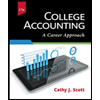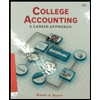
1.
Introduction:
Step-down method: The
Allocation of the service department’s cost to the consuming department and the predetermined overhead rates in the operating department.
2.
Introduction:
Direct method: Under the direct method, the overhead costs incurred by the supporting department are directly allocated to the operating department.
Allocation of the service department’s cost to the consuming department using the direct method and the predetermined overhead rate.
3.
Step-down method: The overhead costs of supporting incurred by the supporting department are allocated to other supporting departments and also the operating department based on the allocation base.
The amount of overhead cost for the job using overhead rates computed in parts 1 and 2.
3.
b.
Step-down method: The overhead costs of supporting incurred by the supporting department are allocated to other supporting departments and also the operating department based on the allocation base.
The reason the step-down method is a better base for computing the predetermined rates than the direct method.
Want to see the full answer?
Check out a sample textbook solution
Chapter 5 Solutions
FUND.ACCT.PRINC.(LL) 25E <C> W/ CONNECT
- America Manufacturing has determined a standard direct material cost per unit of $9.20 (4 pounds at $2.30 per pound). Last month, America purchased and used 8,500 pounds of direct materials, for which it paid $18,700. The company produced and sold 2,100 units during the month. Calculate the direct materials price variance, direct materials quantity variance, and direct materials spending variance.arrow_forwardI want Answerarrow_forwardPlease show me the correct way to solve this financial accounting problem with accurate methods.arrow_forward
 College Accounting (Book Only): A Career ApproachAccountingISBN:9781337280570Author:Scott, Cathy J.Publisher:South-Western College Pub
College Accounting (Book Only): A Career ApproachAccountingISBN:9781337280570Author:Scott, Cathy J.Publisher:South-Western College Pub Financial Accounting: The Impact on Decision Make...AccountingISBN:9781305654174Author:Gary A. Porter, Curtis L. NortonPublisher:Cengage Learning
Financial Accounting: The Impact on Decision Make...AccountingISBN:9781305654174Author:Gary A. Porter, Curtis L. NortonPublisher:Cengage Learning College Accounting, Chapters 1-27AccountingISBN:9781337794756Author:HEINTZ, James A.Publisher:Cengage Learning,
College Accounting, Chapters 1-27AccountingISBN:9781337794756Author:HEINTZ, James A.Publisher:Cengage Learning, Financial AccountingAccountingISBN:9781337272124Author:Carl Warren, James M. Reeve, Jonathan DuchacPublisher:Cengage Learning
Financial AccountingAccountingISBN:9781337272124Author:Carl Warren, James M. Reeve, Jonathan DuchacPublisher:Cengage Learning College Accounting (Book Only): A Career ApproachAccountingISBN:9781305084087Author:Cathy J. ScottPublisher:Cengage LearningPrinciples of Accounting Volume 1AccountingISBN:9781947172685Author:OpenStaxPublisher:OpenStax College
College Accounting (Book Only): A Career ApproachAccountingISBN:9781305084087Author:Cathy J. ScottPublisher:Cengage LearningPrinciples of Accounting Volume 1AccountingISBN:9781947172685Author:OpenStaxPublisher:OpenStax College





